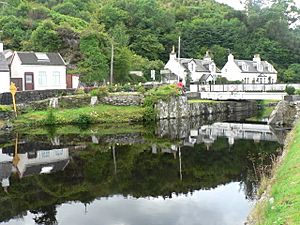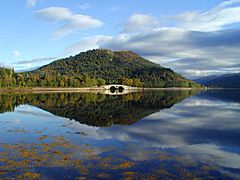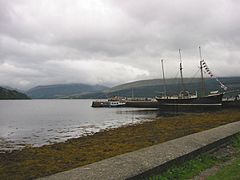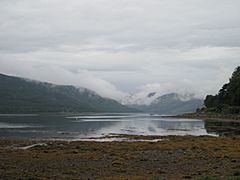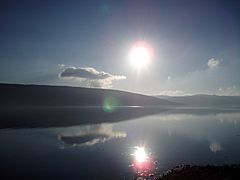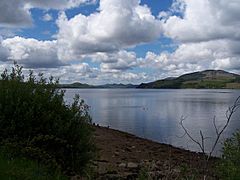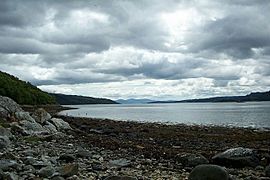Loch Fyne facts for kids
Quick facts for kids Loch Fyne |
|
|---|---|
| Loch Fyne (Loch Gilp, Loch Shira) | |

Head of the loch from near St Catherines
|
|
| Location | Cowal, Argyll and Bute, Scotland. |
| Coordinates | 56°10′19″N 5°06′00″W / 56.172°N 5.100°W, |
| Type | Sea Loch |
| Native name | Vine (wine) lake Loch Fine or Loch Fyne Error {{native name checker}}: parameter value is malformed (help) |
| River sources | Curl Arstich burn, river garron river Fyne lingerton burn king las water allt na craobh uinsinn Allt oigh Allt oich allt na Craig Abhainn Mor Inverneill river Allt Airigh na brodaig Douglas water dalchenna burn Allt Airigh na brodaig Abhainn Srathain Ardfenaig burn Crinan Canal Inverdrishaig water Allt an bog |
| Basin countries | Scotland, United Kingdom |
| Salinity | Seawater |
| Surface elevation | Sea Level |
| Frozen | No |
Loch Fyne is a long sea loch located on the west coast of Scotland. It is found in Argyll and Bute, near the Cowal peninsula. A "sea loch" is like a fjord, a narrow inlet of the sea.
Loch Fyne stretches about 65 kilometers (40 miles) inland. This makes it the longest sea loch in all of Scotland! It connects to the Sound of Jura through the Crinan Canal. The name "Loch Fyne" comes from a Scottish Gaelic phrase meaning "Loch of the Vine/Wine." This name likely honors the nearby River Fyne.
The area around the northern part of the loch is very mountainous. Here you can find the Arrochar Alps and beautiful glens like Glen Shira and Glen Fyne. A special old monument called the Tinkers' Heart overlooks the loch. It was a traditional place for Scottish Gypsy and Traveller groups to hold weddings.
Contents
Getting Around Loch Fyne
Roads Around the Loch
Several roads follow the shores of Loch Fyne. The A83 road goes around the top of the loch. It then travels down the western side. On the eastern side, the A815 road follows the coast. These roads connect many small towns and villages around the loch.
Ferries Across the Loch
You can cross the mouth of Loch Fyne by ferry. A special vehicle ferry travels between Portavadie on the east side and Tarbert on the west side. This ferry makes it easy to travel between the Cowal and Kintyre peninsulas.
The Crinan Canal
The Crinan Canal is a waterway that links Loch Fyne to the Sound of Jura. It starts at Ardrishaig on Loch Fyne and ends at Crinan. This canal is very useful for smaller boats. It allows them to travel to the Hebrides islands without going all the way around the Kintyre peninsula.
The canal is about 9 miles long and has fifteen locks. Locks are like water elevators that help boats move between different water levels. The canal was first opened in 1801.
Loch Fyne's History
World War Two Training
During the Second World War, Loch Fyne played an important role. A training center called HMS Quebec was set up near Inveraray. This center taught soldiers, sailors, and airmen how to use landing craft. They also learned how to set up a beachhead, which is a safe area on an enemy shore.
Around 250,000 people trained here by 1944. This included troops from different allied countries. Today, the main training site is a caravan park.
Nature and Wildlife
Loch Fyne is home to many amazing animals. You might spot dolphins swimming in the water. Seals and otters also live here. In the summer, large basking sharks can sometimes be seen. These sharks are harmless and eat tiny plankton.
In 2014, Loch Fyne was made a Nature Conservation Marine Protected Area. This means the loch is a special place where nature is protected. This helps keep the animals and their homes safe.
Fishing in Loch Fyne
Loch Fyne is famous for its delicious seafood. It is well-known for its oysters. In fact, a popular seafood company, Loch Fyne Oysters, got its name from this loch. The loch is also known for its herring fish. These fish are used to make "Loch Fyne Kippers," a type of smoked herring.
Fishermen have caught some very large fish in Loch Fyne. For example, a blackmouthed dogfish weighing over 1.2 kilograms (2.8 pounds) was caught here.
Fun Things to Do
Diving Adventures
Loch Fyne is a popular spot for sport diving. Divers can explore interesting underwater places. Near St Catherines, there is a field of large rocks and even a wrecked speedboat to discover. At Kenmore Point, divers can see Stallion Rock, a unique rock formation rising from the seabed.
Exploring Castles and Gardens
Loch Fyne is a great place for sightseeing. Many historic castles are located around its shores. These include Inveraray Castle, Dunderave Castle, and Kilmory Castle. You can also see the ruins of Castle MacEwen.
Another beautiful place to visit is Crarae Garden. These gardens are managed by the National Trust and offer lovely views over Loch Fyne. They are located about 10 miles south of Inveraray.
Gallery
-
Inveraray Bridge on Loch Fyne. The spires of Inveraray Castle can just be seen on the left.




